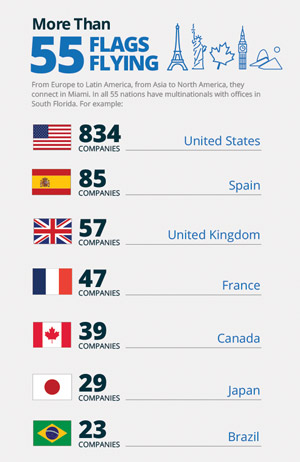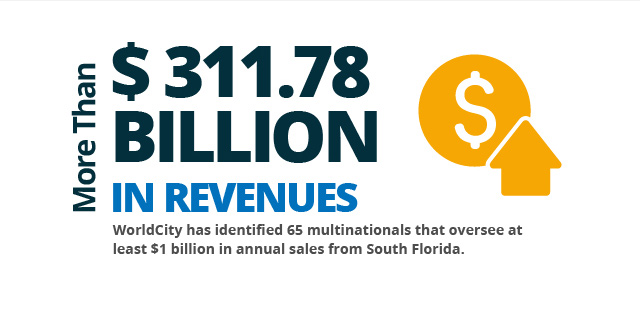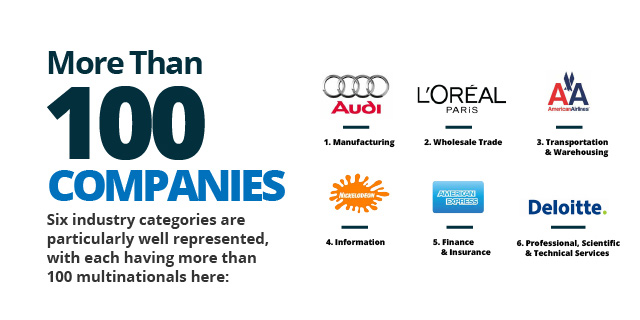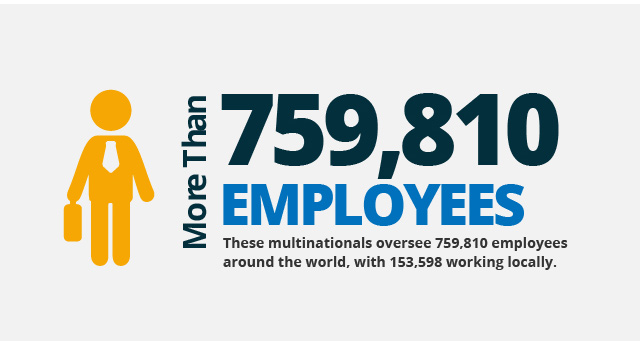1,439 multinationals from 55 nations in South Florida, and there are at least 4 key reasons
Sponsored By
South Florida is awash with multinationals, and there are many reasons.
All 10 of the world’s largest logistics firms have offices in South Florida, according to WorldCity’s Who’s Here research. Eight of the world’s top 10 public relations firms. Six of the world’s largest software companies. Three of the largest five advertising groups. All five of the world’s largest accounting firms.
The 1,439 multinationals represent 55 nations from around the world. While the bulk are, not surprisingly, U.S.-based multinationals and while European countries Spain and the United Kingdom dominate the list of foreign countries represented, they come from every continent in the world save one, Antarctica.
It is important to understand why all these multinationals are here not just as an academic exercise but to ensure South Florida continues to attract and nurture them.
They oversee more than $311 billion in annual revenues from here – WorldCity’s conservative estimate since this is a particularly difficult gem to mine among the thousands of data points WorldCity gathers from these companies, their publicists, internet research, emails and good, old-fashioned sleuthing. At least 65 of these multinationals oversee in excess of $1 billion.
From here, these multinationals manage 759,810 employees around the world, with 153,598 based in the tri-country South Florida market and the rest scattered throughout Latin America, the Caribbean and around the globe.
About three-fourths of the multinationals oversee Latin America as part or all of their portfolio – 30.6 percent just Latin America, another 18.8 percent the Americas (usually excluding the United States, sometimes not) and 24.7 percent the world.
It is important to understand why all these multinationals are here not just as an academic exercise but to ensure South Florida continues to attract and nurture them, that this not become “just another hotel” for them, a place without a sense of home.
The reasons for South Florida being awash in multinationals, the reason South Florida, and Miami more specifically, have come to be known as both the Capital of Latin America or the Gateway to Latin America, can safely be attributed to at least four factors.
- The most obvious for many is the Cubans who fled the island to resettle here after Fidel Castro took power more than half a century ago, bringing with them their wealth, but more importantly their culture, intellect and, perhaps most importantly, entrepreneurial spirit.They created an environment that, in the years that followed, would be welcoming to the fellow Hispanics that fled troubles in their respective countries, most prominently Nicaraguans, Venezuelans and Colombians. There are other reasons for the multinationals being here, of course. Some obvious, some less so.It’s the ocean, it’s the air, it’s the air conditioning – don’t think South Florida would work without it about nine months of the year. No, it doesn’t freeze here, as Mary Brickell famously revealed to Henry Flagler in convincing him to send his rail line this far south, but 10 months of the year it’s pretty warm.
- For the export-import trade to flourish, a development that gave rise to the “Gateway” moniker, Miami needed a real port, had to step up for the ships pulling in to Biscayne Bay. And it was the wisdom of the maritime community and government leaders at about the same time to add fill to what some old-timers still call Dodge Island as well as two smaller islands to create what is today PortMiami. And that allowed, for example, a Colombian who had resettled here to begin sending all sorts of goods back to his tio, sobrinos, amigos – his uncle, nephews, friends – for resale there. The freight forwarding and logistics industry that is so strong in South Florida, and from which more than a few fortunes have been built, was on its way.Today, PortMiami is a vital link in the $100-plus billion two-way trade that passes through Miami-Dade, Broward and Palm Beach counties, along with the two other cornerstones, Port Everglades in Fort Lauderdale and Miami International Airport.
- MIA is a third critical reason South Florida is so comfortable for multinationals – not just so they can ship cell phones out, fish and flowers in – but so that the executives who live and play here can work in Latin America and the Caribbean. They “take a plane to work, rather than a car.” MIA has more flights to “the region,” as well call it here, than all other U.S. airports combined. In fact, Miami is unique in that it is the first major U.S. city to have been created by the airport. While New York was put on the map because of mighty (at the time, anyway) ocean-going vessels, and Los Angeles created by the American love affair with the automobile, Miami was really put on the map by aviation pioneers like Pan American Airways, by Eddie Rickenbacker and his Eastern Air Lines and even by National Airlines – it was founded by George Baker, whose name is on the aviation school across from the airport on Lejeune Road, highly visible because of the jet fronting the building.
- And then there’s air conditioning. Anyone who has lived in South Florida long enough to have experienced a strong hurricane and subsequent multi-day outage of air conditioning understands fully its critical nature.Combine the rich cultural diversity, the three seaports – including also the Port of Palm Beach – MIA and air conditioning and you have all the makings of a region that better connects to the global economy than the national one, what academicians around the world call a “world city.”And so they come.
The driver, all too often, on where a multinational locates is nothing more complicated than the wishes of the top executive
They settle all across South Florida but the strongest concentrations tend to encircle MIA, much in the same way that a pebble dropped in a calm pond leaves the strongest ripples around the point of entry. Coral Gables was one of the first to benefit from the explosion of multinationals, a growth that over the years expanded to equally if not more-dominant office parks of Blue Lagoon and Doral – an area rebranded from Airport West after its incorporation.
The bankers, lawyers and accountants still cluster in downtown Miami and along Brickell Avenue. Certain industries – particularly the creative ones in media and technology – often find their way to Miami Beach.
Fort Lauderdale and Broward County continue to increase the presence of multinationals, as Miami’s density continues to increase, bringing with it things appealing to many but not all. Technology companies and others find Fort Lauderdale suitable, as well as those attracted to a more suburban lifestyle in places like Weston and Plantation.
The driver, all too often, on where a multinational locates is nothing more complicated than the wishes of the top executive, who might be driven by access to the airport or a spouse’s desires.
These companies tend to be run by men – more than eight in 10, according to WorldCity research – so more often than not, that spouse is the wife and mother. But, suffice it to say, in a region of 5 million people, there are many options for the “perfect place to live” and many factors to consider – from schools to the view to land to the daily commute to previous experience to age and life stage.
Not all are jefes, of course, and what’s best for the boss might not be best for all, at least when it comes to where to live. Which positions are staffed in South Florida for these multinationals is most predictable by size and industry. These multinational operations are generally sales offices. The larger companies tend to have a human resources director and, sometimes, a team of HR professionals. The same is true for marketing and public relations.
Some will have a chief financial officer positions but often back office functions can remain either in headquarters or in the region. Certain industries have government affairs or public policy officials here – chiefly financial, logistics and health-care, and particularly the larger global brands in each – since the dozens of countries under their purview often are characterized by complicated, contradicting and fast-changing regulatory environments.
Double-digit growth is commonplace with many of the 1,400-plus multinationals who ply their trade in Latin America – both as an expectation of headquarters and a result.
As these executives settle in, some for good, some for relatively short stints on the road to the next promotion, some like to be near those from their own country.
Brazilians – an increasingly important nationality since many of the multinationals here conduct in the range of 40 percent of their business there and because it is South Florida’s No. 1 trade partner – have a strong presence in Pompano Beach in north Broward County. Venezuelans are a strong presence in both Weston and Doral, where the mayor is a Venezuelan-American.
Other areas, of course, have connections to homelands, though not necessarily because of multinational behavior. Little Haiti is an area north of downtown Miami. While Little Havana was once home to the Cuban diaspora, it is now home to many coming from Central America as Cubans have spread out into all areas of Miami-Dade, Broward County and beyond. The area north of downtown Miami now known as Wynwood was once called Little Puerto Rico.
Into this tapestry of lifestyle choices enter the multinationals. But not every multinational is here.
Yes, all 10 of the top 10 logistics firms and all five of the top five accounting firms are here. But only four of the top 10 architectural firms, three of the world’s 10 largest law firms and – though this is likely to change, given an initiative to make Miami a transportation hub – only four of the world’s top pharmaceutical firms.
As the middle class has risen in Latin America and the Caribbean in the last decade or two, it has created enormous opportunity for multinationals operating in South Florida. While that includes the pharmaceutical and medical device companies, who are moving beyond life-saving to life-enhancing products, it also includes those selling computers, printers and cell phones. For that reason, South Florida leads the nation in the export of many technology products – and is home to several of the world’s largest tech distributors – and ranks fourth for the export of leading medicine categories.
Double-digit growth is commonplace with many of the 1,400-plus multinationals who ply their trade in Latin America – both as an expectation of headquarters and a result. While many of these multinationals once reported 3-4 percent of global revenues, it is now more common to hear 6-8 percent.
As Latin America has prospered, something else has started happening. An increasing number of multilatinas have started coming to South Florida.
Larger Brazilian, Argentine, Colombian and Mexican multinationals, and others, looking to gain a footing in the lucrative U.S. and North American market find South Florida to be welcoming.
After all, it has the diversity and cultural connections, frequent flights home, ports that can carry their goods and, of course, air conditioning.
Download a pdf of the annual Who’s Here publication, order a printed copy or purchase the database by clicking here.




